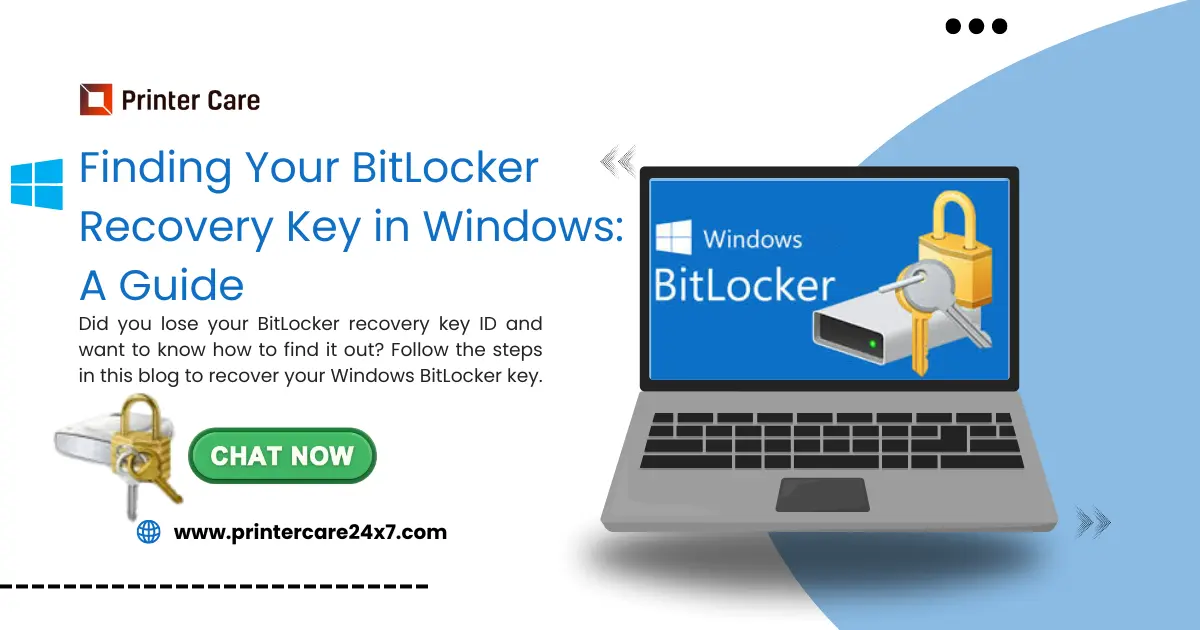101 Guide to Find BitLocker Recovery Key With ID and Email
The BitLocker recovery key is a unique 48-digit code to unlock files or encrypted drives. This is a backup to unlock the drive if BitLocker loses access or hardware changes. It is critical for data security and providing authorized access to uses for encrypted data. Access to encrypted data with the BitLocker recovery key is impossible, so safeguarding it is essential. Users can save this in their Microsoft Account or store it securely elsewhere.
First, let’s learn what a BitLocker is, and then we will move on to other sections of the blog and gain more information about what you can do to ensure you find your BitLocker recovery key.
What Is A BitLocker Key?
BitLocker is a full disk encryption feature available in Enterprise and Ultimate editions of Windows Vista and Windows 7, Pro and Enterprise editions of Windows 8 and 8.1, etc. It encrypts data by ciphering the whole hard drive, including system files. This way, BitLocker prevents unwanted data access and ensures safety. BitLocker is mostly used in business but can also be used by people to bolster the security of their PCs in their daily lives.
We have learned about BitLocker. Check out the section below to learn what a BitLocker recovery key ID is.
Why BitLocker Recovery Key ID Is Important?
If your BitLocker cannot confirm that the attempt to access the system is authorized, this BitLocker recovery key can unlock it. The BitLocker key ID is issued during the BitLocker installation. Users can generally store the Windows BitLocker key on a USB flash drive and then plug in the flash drive when they need to use the key.
Even after learning about BitLocker and BitLocker keys, it’s important to understand why the computer asks for a BitLocker Recovery key ID.
Why Does Your Computer Need A BitLocker Recovery Key?
There are several reasons why your system can ask for the BitLocker recovery key ID. It could be because the system’s hardware has been changed, the software has been updated, the BIOS has been changed, or a system glitch has occurred. In such situations, you must remember the BitLocker key ID to access your system.
The following is the most important section of this blog. Here, we will learn methods to find the BitLocker recovery Key ID.
How To Find The BitLocker Recovery Key?
Now that you know that the BitLocker key ID is a 48-digit password, it’s no surprise that people tend to forget it. You can store the key in a USB flash drive. However, if you lost the drive, you lost the recovery key of BitLocker, too. In this scenario, you must know how to recover the Windows BitLocker key ID. Keep reading to learn about BitLocker key recovery options.
Find The BitLocker Recovery Key Using The Microsoft Account
Your BitLocker recovery key is saved in your Microsoft account, which is easy to access. The first step in the BitLocker key recovery options is to visit your Microsoft account. Follow the steps below to recover the BitLocker key ID.
- First of all, open a web browser on any of your devices.
- Type https://account.microsoft.com/devices/recoverykey.
- Enter your Microsoft ID and visit the page.
- You will find the BitLocker recovery key ID there.

f someone else set up your system and activated BitLocker, you will find the lost recovery key in their Microsoft account.
Find The BitLocker Recovery Key Using The Powershell
Powershell is the second among the BitLocker key recovery options if you have somehow lost the BitLocker key. It is a cross-platform tool in Windows that helps us automate tasks, manage configurations, and write scripts.
- Press Windows+X and select Windows Powershell.
- In the Powershell Window, type (Get-BitLockerVolume) and press enter.
- Find the drive requiring the BitLocker recovery key.
- Note the Volume Type and Mount Point values associated with this drive.
- Replace the given MountPoint with the actual Mount Point of the drive using the command (Get-BitLockerVolume-Mountpoint <Mount Point> . keyprotector).
- Press the enter button to see the lost recovery key with the drive..
Find The BitLocker Recovery Key Offline
This method works if your internet connection is down. You can recover the Windows BitLocker key offline using it.
- If you have ever printed or saved a copy of your BitLocker recovery key ID, bring it out.
- If you don't have a printed copy, check your emails, text files, or even photographs, which may contain the lost recovery key.
- If you have saved the key ID on a USB drive, insert it into your PC and look for files containing the recovery key.
- If you are a working professional, your system administrator must have a record of the BitLocker key ID.
You have learned the BitLocker recovery process. But what if you can not find your BitLocker recovery key even after utilizing all the above-mentioned steps? Are you confused? Then, keep reading the blog to find the solution.
What If You Can’t Find The BitLocker Recovery Key?
There are two options if you fail to find the Windows BitLocker key ID even after utilizing the steps given in the blog. Keep following the blog to find out what you can do:
1. Check Out Other Recovery Options
More often than not, people link their Microsoft account to multiple devices, which may also be the case with you. If you have a single Microsoft account linked to multiple devices, check them out for a recovery key. Sometimes, we don’t remember, but such devices can store our Bitlocker recovery key. So they can help with the BitLocker recovery process.
2. Use Data Recovery Services
It rarely happens, but sometimes, all the BitLocker key recovery options fail. If you face this situation, consider utilizing professional data recovery services. These services specialize in retrieving data from encrypted drives and can help you recover your lost recovery key ID.
We have learned how to find a BitLocker recovery key. But what if you already have one, and it’s invalid? To avoid this case, you must verify the key ID. But how to do so? Find out in the following section.
How To Verify A BitLocker Recovery Key?
To verify the Windows BitLocker Key ID, you need to follow some steps. Below are steps that you need to follow to verify your BitLocker key ID.
- Open the BitLocker recovery verification tool by entering the “recovery key” into the Windows search box.
- Choose “Verify BitLocker key”
- Enter the 48-digit recovery key and click on verify.
- After completing the process, the tool will show whether the recovery key is valid.
We have almost finished the blog, and the next section is about how to store your BitLocker key.
Best Practices To Store Your BitLocker Recovery Key
There are three methods to store your BitLocker recovery key ID. Keep reading to learn these methods and store your BitLocker key ID.
1. Print Copies
The first method is to print a hard copy of your recovery key ID and store it securely, such as in a locked drawer or a deposit box.
2. Utilize A Password Manager
Using a password manager would be great if you added the recovery key ID to that. Password managers have data encryption and backup features to store sensitive information, including BitLocker recovery key ID effectively.
3. Option For Cloud Services
Another solution for storing your recovery key ID is a digital cloud service. You can upload a digital copy of your BitLocker key ID to a cloud storage provider. Ninja One is a great platform for This.
Retrieving BitLocker Recovery Key ID: Simple Steps To Follow
Data Security will always remain crucial in this ever-evolving digital era. Using easy-to-use security and encryption features, like BitLocker, can effectively protect sensitive data and devices. Some tools, such as MBAM, Manage-bde.exe, BitLocker cmdlets, File Explorer, etc., can help you optimize your BitLocker to leverage the best security possible. If you lost the recovery key of BitLocker by any chance and can’t find it, contact us. We are professionals in this field and will help you recover your BitLocker recovery key in no time at all.
Read More Blogs: Android Data Recovery
Frequently Asked Questions (FAQs)
1. How to avoid BitLocker recovery?
Navigate to Troubleshoot, and go to startup settings. Press restart and press the ESC button to avoid BitLocker recovery.
2. Why is the BitLocker Recovery key not typing?
You must be typing in letters. If you are typing in numbers, press the fn+numlock key.
3. How to unlock BitLocker in CMD?
Use the command: manage-bde-unlock-X:-Password or manage-bde -unlockX:-Recovery Password.
4. How many attempts does the BitLocker key provide?
It provides only 32 attempts.

